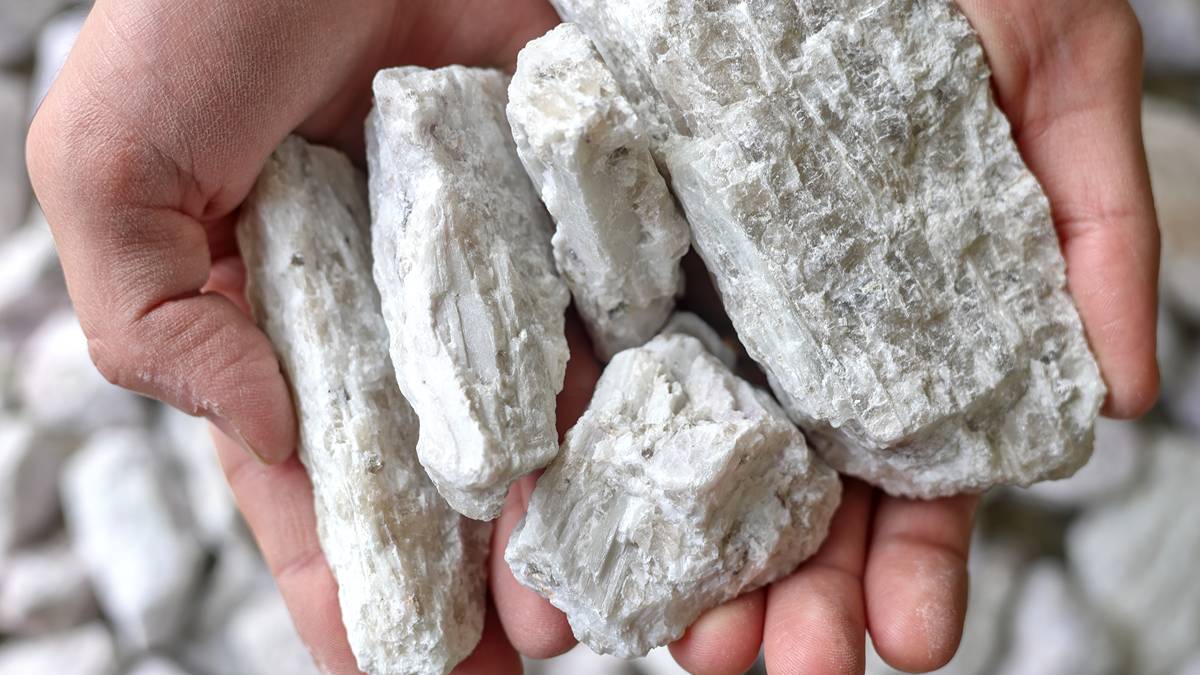Suspension of giant Chinese mine another lift for lithium revival

This white rock is about to get a bit more expensive, thanks to a Chinese mine shut. Pic: Getty Images
- CATL’s giant Jianxiawo lepidolite mine suspended for at least three months over permits
- Lithium prices have gained on supply concerns amidst speculation suspension could last up to 12 months
- Australian spodumene producers have marked big gains today on the news
Lithium tailwinds are getting sturdier on news that China’s largest lithium battery producer CATL has been forced by Chinese regulators to suspend operations at the Jianxiawo lepidolite mine in Jiangxi province.
Benchmark Mineral Intelligence estimates the mine produces around 3% of the world’s lithium raw material supply, making the suspension a bellwether for sentiment on lithium pricing, which has been crunched by a supply flood following 2022’s price boom.
It’s the second time the mine has been shut in less than a year. This time it will reportedly last for at least three months and it’s due to non-compliance with permitting requirements.
Interesting that @catl_official is learning they aren’t more powerful than regulators. China will retain controlling influence over #lithium price for at least a few more years but it is clear the Middle Kingdom knows price has to rise. https://t.co/4KiZ2MzBFK
— Joe Lowry (@globallithium) August 10, 2025
That had tails up across the ASX lithium space on Monday.
Liontown Resources (ASX:LTR) jumped 17.75% to close at 99.5c despite having just raised $316m at 73c through a two-tranche placement last week, while Pilbara Minerals (ASX:PLS) took to the skies with a 19.17% gain to $2.30.
Mineral Resources (ASX:MIN) ran 11.68% to $37.95 while IGO (ASX:IGO) lagged behind its peers with an 8.6% rise to $5.43.
Meanwhile, Piedmont Lithium (ASX:PLL), which is in the process of merging with Sayona Mining (ASX:SYA), rose 15.39% to 15c.
Advanced explorers such as Lake Resources (ASX:LKE), Core Lithium (ASX:CXO), ioneer (ASX:INR) and Argosy Minerals (ASX:AGY), which have feasibility studies in place or which are progressing towards an investment decision, also saw big gains.
AGY soared 31.03% to 3.8c, CXO gained 12.5% to 11.3c, INR was ~21% higher and LKE is up 10.26% to 4.3c.
The impact
Shutting Jianxiawo is expected to have a noticeable impact on lithium supplies. UBS estimates it provides feedstock for 8% of China’s lithium carbonate production.
The suspension could also last longer than three months, with MST Financial saying that it was due to CATL not renewing its kaolin mining licence following scrutiny over state control of strategic resources under the updated Mineral Resources Law, which is aimed at countering practices that lead to destructive pricing practices.
MST believes this could result in the suspension lasting up to 12 months, which reflects the timeline of a review process of CATL’s mining licence renewal.
It follows the closure of eight lepidolite operations in Yichun and a crackdown in Haixi on a mine run by Zijin subsidiary Zangge Mining – with local authorities now enacting the Chinese Government’s aims to limit the competition that has sent prices of the battery metal spiralling.
Canaccord Genuity’s Reg Spencer said in a note that the broker had already factored in some closures of higher cost lepidolite operations into its modelling, expecting to see lepidolite supply of ~85,000t lithium carbonate equivalent vs reported capacity of between 120,000t and 150,000t LCE, recovering to 120,000t LCE in 2026.
“Given the importance of these operations to local employment and tax revenues we expect it is in the country’s interest to maintain profitable operations,” Spencer said.
“However, should these suspensions be extended through to 2026 we highlight risk to our small surplus modelled in 2026.”
Canaccord recently suggested investors should ‘reassess’ sector exposure as market fundamentals improve.
Any impact on lepidolite supply will be welcomed by Australian spodumene producers, who have seen prices drop as low as ~US$600/t for the benchmark 6% Li2O benchmark grade of their hard rock lithium product this year.
Fetching US$8000/t at spot rates just two and a half years earlier, the price dive has sent virtually all lithium producers into lossmaking territory.
But demand for the metal from both electric vehicles and, increasingly, stationary energy storage, continues to increase.
Lithium prices have already moved, with lithium carbonate futures on the Guangzhou Futures Exchange rising 8% by mid-day on Monday to 80,560 yuan ($17,196) per tonne.
Spodumene supply from Australian producers is also likely to be welcomed by Chinese refiners given they have a well-deserved reputation for reliable supply.
This is important as the refiners need feedstock to maintain their production of lithium-ion batteries to meet growing BEV and energy storage demand.
Hold your horses
But Benchmark lithium product director Dr Cam Perks warned the Jianxiawo closure would not necessarily have as big an impact on global supply and demand flows as investors are tipping with their ASX lithium splurge.
Jianxiawo is currently responsible for 30% of local supply to Jiangxi’s lithium refineries, according to Perks, and its centrality to the local economy means it’s likely the mine will be restarted, in his view.
“I think it’s become this bellwether for the global lithium supply and demand picture for some reason,” he said.
“We did see prices increase after it was shut last time, so of course we’re seeing it this time. We’ve already seen it because of the GFEX.
“If we looked at the GFEX for the last week, it’s just kept going up and up.
“So it’s hardly a surprise, to be honest (that it shut). But I think the Chinese market is a gambling market, to some extent and then the GFEX now has such big importance on the global lithium stage.
“A lot of Western prices are linked to Chinese prices.”
The big difference this time around is that the shut has come not from CATL, which engineered last year’s shut due to financial losses, but from Chinese regulators.
Even is the price run up is stark in the short term, it doesn’t mean Jianxiawo’s temporary closure will completely alter supply and demand fundamentals.
Benchmark sees the market heading into balance in 2027, with prices likely to be rangebound until a small deficit re-emerges around 2029.
Where it could benefit Australian players is that it puts uncertainty around the supply of feedstock from within China, which remains the key customer for Aussie lithium producers. Ensuring a reliable source of lithium raw materials supply remains open for their refineries is key for the downstream market in China.
“There’s no huge fundamentals impacted, in my opinion, but there’s already a dynamic on feedstock availability versus processing capacity in China,” Perks said.
“Obviously there’s huge overcapacity of processing and not enough feedstock to feed at all. So there was already a bit of dynamic playing out there, a little bit more strength in spot recently than there was in the broader market.”
Potentially reflecting that dynamic, China’s Canmax Technologies took a 2% stake in local player Liontown Resources (ASX:LTR) in a $50m investment last week that placed the lithium refiner alongside the Federal Government’s National Reconstruction Fund as one of the Kathleen Valley mine owner’s newest and larger shareholders.
Related Topics

UNLOCK INSIGHTS
Discover the untold stories of emerging ASX stocks.
Daily news and expert analysis, it's free to subscribe.
By proceeding, you confirm you understand that we handle personal information in accordance with our Privacy Policy.








